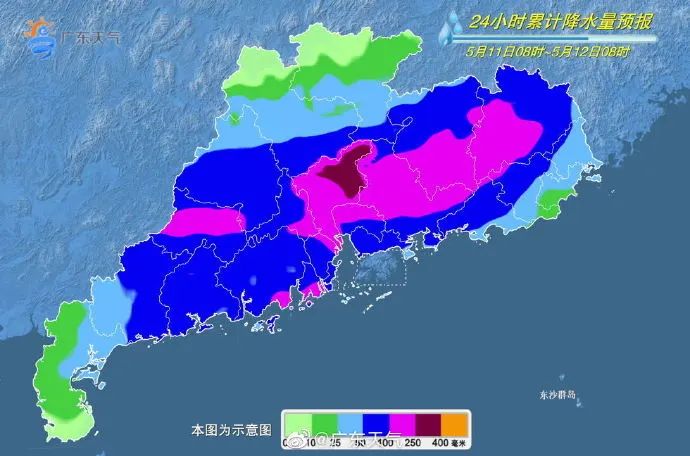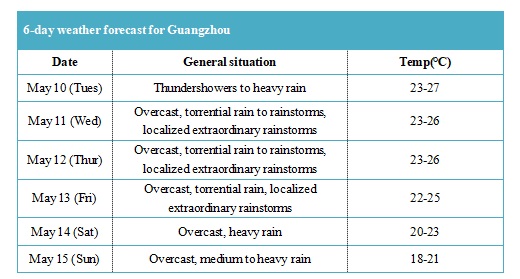Source:GDToday 广州外事
A new round of rainstorms is forecast to lash Guangdong from May 10 to 13, which the local provincial meteorological bureau predicts will be the heaviest, the most extensive, and what's more, the longest running rainfall so far this year.
Heavy rainfall will fall mainly during the late afternoon and the wee hours of the morning. Guangzhou is expected to see the strongest rainfall from May 11 to 12, which may lead to the highest increase in water level this year the city's Hydrology Bureau announced.

The rain will start to bucket in the central-northern Pearl River Delta, Shaoguan, Qingyuan, Maoming and Heyuan tomorrow. Other regions will see thundershowers, and localized heavy rain. The highs in the north of Guangdong will be 23℃ to 25℃, 25℃ to 29℃ in the rest of the province.
From May 11 to 12, rain will pour down all over the province, and even localized extraordinary rainstorms are possible. The highs in the coastal regions of southern Guangdong will be 25℃ to 29℃, 21℃ to 24℃ in other regions.
On May 13, there will be heavy downpours in the central-southern Pearl River Delta, east Guangdong and west Guangdong. Other regions are to experience heavy rain, and localized rainstorms.
Meanwhile, the north of Guangdong will welcome a new wave of cold air, ushering in a new round of significant temperature drops for the whole province. The lows in central-northern Guangdong will be around 15℃, and 18℃ in other regions.
Plentiful rainfall is still expected in the southern coastal areas of the province on May 14. The lows in the central-northern Guangdong will be 14℃ to 16℃, and 16℃ to 18℃ in other regions.

For your safety,please take the following precautions:
I Travel precautions
1. Avoid standing advertising boards, transformers, electric poles and other dangerous objects.
2. Keep away from temporary enclosures on construction sites and fences built on the hillside.
3. Don't wade forward rashly. Keep alert to well covers, sewers, sewage wells, etc. If you find whirlpools on the road, do carefully bypass them.
4. Before driving, please check your car carefully to ensure that the engine cover and doors are completely closed and the wipers and brakes are in good conditions. Eliminate any car defects in time.
5. Keep away from electric poles, transformers and other equipment to prevent electric shock. If someone is found to be electrocuted and fell into the water, do not rush to get close to rescue. Remember to cut off the power immediately when the house is flooded and beware of electric shock.
6. When driving, keep a low speed and keep distance between vehicles. When visibility is hampered in rainy days, turn on the anti-fog light.
7. When the water on the roadside is lower than half a wheel, the vehicle can generally pass normally, but slow down and be careful not to induce water inflows that might lead to a shutdown of the engine.
8. If the vehicle stalls during wading, evacuate the dangerous area quickly before the water level fully rises. DON’T wait for rescue in the vehicle, so as to avoid automatic locking of electric doors and windows when the water level is too high, which might endanger personal safety.
II Rainstorms precautions
1. Ensure smooth drainage of floor drains and ditches. When the wind gains momentum, sandbags shall be used to block the glass gates of the community and other doors and windows of households.
2. During the period of strong wind, elevator services can be suspended if the wind pressure is too high and affects its normal operation.
3. During the period of strong wind, patrol inspection shall be strengthened. If there is a possibility of falling objects, some affected places can be temporarily closed. The block can be lifted until the dangerous situation is eliminated.
4. Rain and wind proof measures shall be taken in advance for major outdoor activities, nucleic acid testing points and material transportation.
III Flood precautions
1. Make full preparations and transfer to a high place for rescue is the top principle.
In case of flood, you should immediately transfer to the first floor of a solid building to avoid risks, and try to get in touch with rescue departments. Meantime, pay attention to collecting all kinds of floating objects. Wooden plates and barrels are good tools to survive floods.
2. Move to a higher place immediately if you have no time to transfer or are trapped outdoor.
Don’t panic. You can transfer to a higher place (such as a solid building roof or a big tree) and wait for rescue workers. To prevent the flood from pouring into the house, first block all the gaps under the door. It is best to put sandbags on the outside of the threshold. The sandbags can be sacks, straw bags, cloth bags and plastic bags, which are filled with sand, soil and gravel. If the flood is expected to rise, sandbags should also be piled outside the windows in lower floors. If the flood keeps rising, store upstairs some food, drinking water, clothes and appliances for boiling water.
3. Try to move to a higher ground if you are trapped in the suburbs and are not able to find buildings.
Be careful and pay special attention to avoid the possible route of mountain torrents which might sweep you away. Do not climb the electrified electric poles and iron towers. When the high-voltage line tower is inclined or the wire is broken and sagging, you must quickly move away to prevent direct electric shock or electric shock due to "step voltage" on the ground.
4. How to survive a drowning car ?
When the car falling into the water, untie the safety belt immediately and open the door for it is the safest and fastest way to escape. The car will not sink to the bottom instantly after falling into water. Open the electronic central lock immediately to prevent the door lock from failure. However, if the central lock is powered off or the water pressure is too high to open the door, we can only try the following method: smash the window and escape as soon as possible. It takes time for the car to sink to the bottom, so don't be afraid of an instant sinking when you open the window. We should first strive for time to escape for the car will sink to the bottom in 5 to 10 seconds after opening the door. At the critical moment, you must abandon your car and escape.